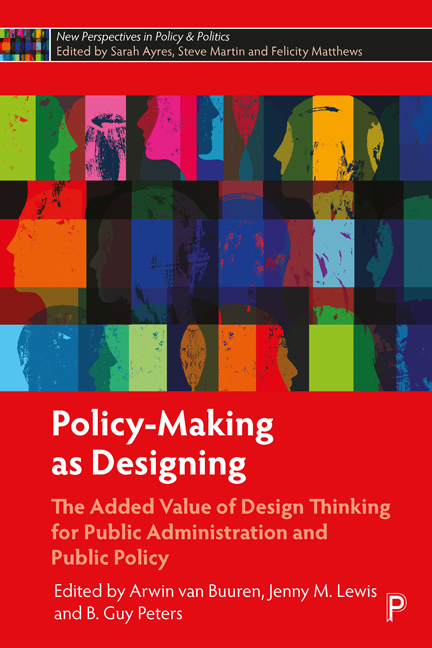 Policy-Making as Designing
Policy-Making as Designing Book contents
- Frontmatter
- Contents
- List of figures and tables
- Notes on contributors
- 1 Improving public policy and administration: exploring the potential of design
- 2 Applying design in public administration: a literature review to explore the state of the art
- 3 Challenges in applying design thinking to public policy: dealing with the varieties of policy formulation and their vicissitudes
- 4 Designing environments for experimentation, learning and innovation in public policy and governance
- 5 Policy Labs: the next frontier of policy design and evaluation?
- 6 When design meets power: design thinking, public sector innovation and the politics of policy-making
- 7 Designing institutions for designing policy
- 8 Applying design science in public policy and administration research
- 9 Using a design approach to create collaborative governance
- 10 Policy-making as designing: taking stock and looking forward
- Index
4 - Designing environments for experimentation, learning and innovation in public policy and governance
Published online by Cambridge University Press: 20 January 2024
- Frontmatter
- Contents
- List of figures and tables
- Notes on contributors
- 1 Improving public policy and administration: exploring the potential of design
- 2 Applying design in public administration: a literature review to explore the state of the art
- 3 Challenges in applying design thinking to public policy: dealing with the varieties of policy formulation and their vicissitudes
- 4 Designing environments for experimentation, learning and innovation in public policy and governance
- 5 Policy Labs: the next frontier of policy design and evaluation?
- 6 When design meets power: design thinking, public sector innovation and the politics of policy-making
- 7 Designing institutions for designing policy
- 8 Applying design science in public policy and administration research
- 9 Using a design approach to create collaborative governance
- 10 Policy-making as designing: taking stock and looking forward
- Index
Summary
Introduction
Research on how the public sector can become more innovative and deliver public value more effectively and efficiently has proliferated over the past two decades (Borins, 2014). Most of this research focuses on innovations in policies and instruments. Moore and Hartley (2008) argue that an important but still understudied category is innovation in governance. Institutional arrangements for nominating complex public problems, developing multi-agency responses and evaluating societal outcomes can themselves be innovations.
Given the complexities of reconciling perspectives and interests across institutions and sectors, designing innovations in governance to achieve improved social outcomes is challenging (Bardach, 2001; Cels et al, 2012; Forrer et al, 2014). Ansell and Torfing (2014) highlight the importance of setting the right conditions for design processes in collaborative governance contexts. Working in collaborative governance arrangements requires much more attention to questions of composition, role and structure than in traditional government, where these questions are mostly settled and the focus is primarily on policies and instruments. It remains unclear, though, what conditions are conducive to the design of innovative governance arrangements, and how to create them.
Recent design science research has advanced our understanding of the value of design thinking and using the design process for public policy innovations (Bason, 2010; 2017). Existing work tends to focus either on conceptual and theoretical explorations of design processes (Dorst, 2011; Howlett, 2014; Mintrom and Luetjens, 2016) or on case studies (Hillgren et al, 2011; Bryson et al, 2013). It does not formulate and test propositions about the conditions for effective design in today's collaborative governance contexts. Simultaneously, collaborative governance theorists have explored conditions influencing the success of collaborative processes (Ansell and Gash, 2008; Emerson et al, 2012), but this work does not say whether these conditions are conducive for collaborative innovation engaged in policy design nor how to change these conditions in a dynamic design environment.
Bason (2010: 19) claims that for public sector innovation, ‘random incrementalism still seems to be the rule rather than the exception. New thinking often happens by chance and against the odds, and the potential of a more conscious, strategic and systematic approach to innovation across public organisations and sectors is not realised’.
- Type
- Chapter
- Information
- Policy-Making as DesigningThe Added Value of Design Thinking for Public Administration and Public Policy, pp. 72 - 97Publisher: Bristol University PressPrint publication year: 2023


